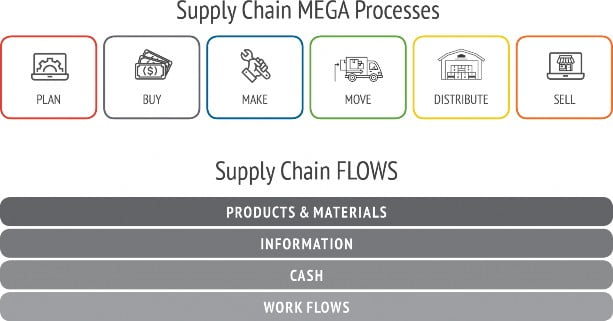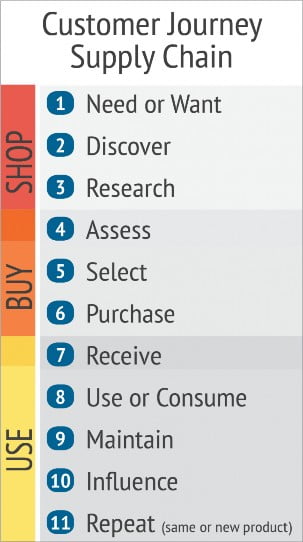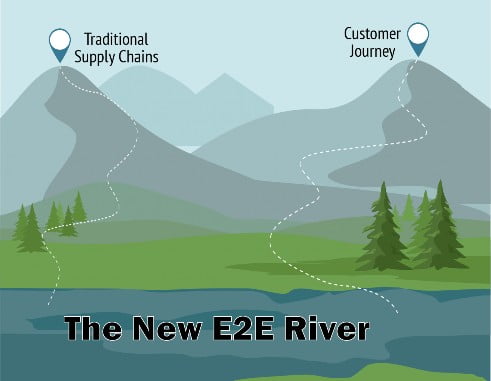Redefining the E2E Supply Chain for Digital Commerce
The New E2E Supply Chain : Combining the Corporate & Customer Journey Supply Chains
Dr. James A. Tompkins, Chairman & CEO Tompkins International
Gene Tyndall, Chief Strategy Officer Tompkins International
Introduction
It is somewhat common knowledge that the rapid growth of Digital Commerce has impacted nearly every company that sells its products online. No matter how retailers, brands or wholesalers have chosen to make their products visible and fulfill their orders, changes- sometimes dramatic ones-have had to be made in strategies, processes, technologies and people.
Traditional supply chains-even those considered superior-have had to adjust to accommodate Digital Commerce, whether B2C, B2B or D2C. The transition from providing bulk products to retail points of sale to allocating specific SKUs to points of fulfillment has not been smooth or simple. Even when engaging with Amazon-the seemingly easiest way for many companies to proceed-has not been without struggles for thousands of companies.
The purpose of this paper is not to enumerate the many issues faced by most companies undergoing this transition; rather, our objective is to redefine what the new end-to-end (E2E) supply chains need to combine with the E2E customer journey.
It is gratifying that supply chains have been highlighted more than ever by executives as value creators and mission critical processes. Digital Commerce has clearly focused management teams in all companies on operations strategies, processes, technologies and people that plan and execute supply chains. The customer journey, however, has not focused enough on its integration with the E2E supply chain. This strategy reflects the next generation E2E supply chain.
The Two Separate E2E Streams are Becoming the New E2E River
- The Traditional Chains
Prior to the revolution in Digital Commerce, and continuing today in most companies, are the various supply chains that have been developed and maintained for decades. At the highest level, the following mega-processes have been used to describe what constitutes traditional supply chains:
PLAN – BUY – MAKE – MOVE – DISTRIBUTE – SELL

Although most models have not included “SELL” in supply chains, we at Tompkins International have done so, knowing that the flow of products does not end with delivery to retail distribution centers (DCs) or other intermediate points prior to points of sale reverse logistics. The leading companies selling to retailers have broadened supply chains to include products on shelves, points of sale, after-sales service and other processes.
The traditional model also recognizes that supply chains incorporate four flows: products (and materials), information, cash and workflows. Superior companies have worked smartly in the past decade on improving the time (speed), costs (margins), information (visibility and collaboration) and work (productivity) that enhance the performance of supply chains, and thus the contribution to value creation and business strategies.
- The Customer Journey
One of the major shifts in Digital Commerce is the introduction and fueling of the ways in which supply chains are “pulled” vs. “pushed.” Traditional chains were used to “push” products downstream to maximize their availability-at retail or other points of sale. Competition for shelf space has been the primary driving factor; however, most companies have found ways to complement that with advertising, promotions and other merchandising actions that create or stimulate demand, thus enabling the push.
Some companies have adopted strategies that lean more on “pull.” If customers demand enough, then supply chains can justify providing enough, without incurring large storage costs. This strategy has proved quite profitable for those companies that were able to “sell one, make one, ship one” as an operations strategy. Lean inventories translated into less working capital and less carrying costs.

The Digital Commerce revolution put this thought on steroids. Customers today decide what to order, when to order, how to order and more and more about pull. Let’s consider what we have termed the customer journey:
We have identified the following 11 steps to a customer order:
While not every customer goes through all 11 steps for each order, most do, whether deliberate or not. These are not business processes-they are customer actions (or thoughts) that are commonly involved in the journey. They also are not sequential or simultaneous. Customers may delay, spend more time researching or dive deeper into any of the steps. The important point is that there is a series of steps that customers undergo for an online order, and many Sellers work to affect these via advertising, increased visibility and other customer- centric actions.
We can also categorize these steps as follows:
Steps 1-4: SHOP
Steps 4-7: BUY
Steps 7-11: USE
Thus, the three mega-processes for the customer journey supply chain are SHOP, BUY and USE.
- The Merger of the Two E2E Streams Becomes the New “E2E River”
Heretofore, Digital Commerce managers have not understood that the two streams do indeed merge. The customer works through their mega-processes until they decide to BUY. The SHOP processes depend on where they go to find, consider and evaluate the products that fill their needs, wants or “must haves.”
The BUY, of course, triggers the traditional supply chain to work. And, the USE depends on the supply chain for “after-sales support,” influencing other BUYs or for returns.
So what does this mean to corporate supply chains? The answer is much more than commonly thought. First, the two streams are interconnected. Second, they influence each other, especially when they merge into the new “E2E River.” Third, they interact at multiple points in the processes.
It is this new E2E River that must be addressed for Digital Commerce efficiency and effectiveness. It is more meaningful than simply providing customer personalization, which is necessary but not sufficient.

Let’s next consider how the new E2E River is different from the two separate streams.
First, identification.
While Sellers continue to operate their traditional supply chains, they are recognizing more and more that individual customers also undergo a chain of processes (i.e., SHOP-BUY-USE). The customer processes pull orders from the site at which they make the BUY decision. Thus, we can view the new E2E River as the customer interacting with Seller to SHOP and BUY; then the forward process of fulfillment occurring to deliver the order.
This two-step process, though obvious, needs to be identified as the two processes working together as a new E2E River for each order transaction. Recognition of these integrated processes is important because it creates the need for sub-processes to be in synch.
Second, interconnectivity.
These two processes are interconnected because the product(s) ordered results from the Seller supply chain but is triggered by the customer processes-namely the BUY decision. This means that the product(s) ordered must be available for fulfillment according to the service selections made by the customer, including timing for delivery, location, packaging, etc. In Distributed Logistics, where selected products are available at the designated locations, the requirement exists that the Seller supply chains must accommodate the customer’s BUY decision. This interconnectivity is necessarily understood by the Seller-and its third-party fulfillment service provider, if contracted-in that inventory allocation and optimization at each location are very important for minimizing working capital and carrying costs.
Third, visibility.
One of the primary factors fueling Digital Commerce is the pace of retail bankruptcies and store closures, and projections are that this trend will continue. The changing consumer behavior means that shoppers are abandoning the nation’s malls and instead are shopping online. The number of store closings in the first half of 2019 has already exceeded the total during 2018, and predictions for all of 2019 are at 12,000 store closings.
It can be debated whether store closings cause online growth or vice versa. Nevertheless, it is clear that Sellers must react to the loss of retail shelf space and sales by expanding their product visibility elsewhere.
Therefore, we need to focus on the new E2E supply chain for Digital Commerce. In order to maximize revenues, Sellers must utilize a wide variety of channels to ensure maximum visibility of their products among customers. We refer to this as the “Sell Anywhere” strategy, which includes the following:
-
By location: Businesses should incorporate a wide range of online and offline channels, including different stores, websites, marketplaces, social media and any other places where customers shop. This also includes various sales methods, such as D2C, first- and third-party, B2B, brick-and-mortar retail and more.
-
By geography: When possible, it is important to broaden your geographic reach outside of the U.S. by selling products worldwide or to select international markets as your operation allows.
-
By customer mindset: Brands need to target customers at each stage of the purchase funnel, including the “awareness” (SHOP) stage, where they go to research various products, as well as the “purchase” (BUY) stage, where customers already know what product(s) they want or need and are ready to buy.
-
By E2E mindset: As customer expectations continue to change and grow, it is important to employ a flexible, anti-brittle supply chain solution that is capable of adapting and evolving to provide a series of options to address what is happening at that moment. Consider the aforementioned new E2E River-brands must combine traditional supply chain strategies with the customer journey processes to ensure long-term profitable growth.
Providing maximum visibility to the customer allows the full customer supply chain to work, enabling the 11 steps of the three mega-processes that convert a need or want to shopping and on to buying. Great content and advanced advertising can further enhance visibility.
At the same time, the new issues are, how can the Seller manage its multiple visibilities and how can its contract service provider know which customer has bought from which site? The interconnectivity of the new E2E River is made complex due to the magnitude of BUY options. Thousands to millions of orders produce a volume of transactions that further complicate operations.
Maximum visibility of products for sale is essential for revenue growth. Yet its management is complicated, even when the customer journey and corporate supply chain are understood as being interconnected.
Fourth, integration.
Listing products for sale on multiple channels, which is critical for revenue growth, presents management challenges of complexities and volumes. As expected, we turn to technology to deal with these challenges; however, the technology industry has struggled to stay ahead (or even catch up) to Sell Anywhere, with one exception-Etail Solutions. Tompkins International has teamed up with Etail Solutions to enable the true E2E supply chain to be defined and managed as suggested in this paper.

Following are a few highlights of the Etail Solutions suite of software products designed for and used by leading digital commerce Sellers:
-
All-in-one platform provides Sellers with complete visibility and control of their entire business-orders, inventory, fulfillment, pricing and shipping-across all online channels.
-
Helps boost margins and supercharge growth-among its clients are companies with millions of SKUs and 100+ million listings on 20+ different channels globally.
-
Automatically updates listings across all channels when costs, supplier price or inventory availability change.
-
Automatically pulls down listings when products are out of stock and republishes when inventory becomes available.
-
Automatically aggregates orders then creates and issues POs to suppliers in their required file formats.
-
Integrates Sellers with their logistics service providers for automated order fulfillment.
These are just a handful of the features and functions available through Etail Solutions, all of which enable the new E2E supply chains by integrating a brand’s entire sales ecosystem into a single platform. Etail Solutions’ clients enjoy its power and flexibility to act quickly and take advantage of its best practices and continuous innovation.
Conclusion
In this paper we have introduced the new E2E Digital Commerce supply chain, which combines both the corporate supply chain and the customer journey, as illustrated through the new E2E River. Redefining the E2E Digital Commerce supply chain creates many opportunities for revenue growth, operations cost reductions and service improvements. The full benefits, however, only accrue if the Seller understands the need to focus on the new E2E supply chain and complete its integration. This strategy, in turn, requires technology that enables multichannel and unichannel management, such as the Tompkins International Digital Commerce strategy and business model and Etail Solutions platform. Together, these solutions possess the needed toolset for enabling the new E2E supply chain, thus providing a unique advantage and highly compelling value proposition for Sellers.


